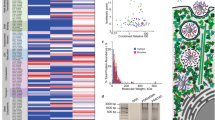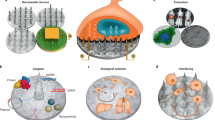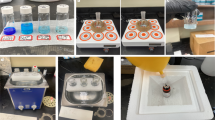Abstract
Self-assembling polycation/DNA complexes represent a promising synthetic vector for gene delivery. However, despite considerable versatility and transfectional activity in vitro, such materials are quickly eliminated from the bloodstream following intravenous injection (plasma α half-life typically less than 5 min). For targeted systemic delivery a more prolonged plasma circulation of the vector is essential. Here we have examined factors contributing to rapid elimination of poly(L-lysine) (pLL)/DNA complexes from the bloodstream, and implicate the binding of proteins to the polyelectrolyte complexes as a likely cause for their blood clearance. pLL/DNA complexes reisolated from serum associate with several proteins, depending on their net charge, although the major band on SDS-PAGE co-migrates with albumin. Serum albumin binds to pLL/DNA complexes in vitro, forming a ternary pLL/DNA/albumin complex which regains some ethidium bromide fluorescence and fails to move during agarose electrophoresis. Albumin also causes increased turbidity of complexes, and reduces their zeta potential to the same level (−16 mV) as is measured in serum. We propose that rapid plasma elimination of polycation/DNA complexes results from their binding serum albumin and other proteins, perhaps due to aggregation and phagocytic capture or accumulation of the ternary complexes in fine capillary beds.
This is a preview of subscription content, access via your institution
Access options
Subscribe to this journal
Receive 12 print issues and online access
$259.00 per year
only $21.58 per issue
Buy this article
- Purchase on Springer Link
- Instant access to full article PDF
Prices may be subject to local taxes which are calculated during checkout








Similar content being viewed by others
References
Marshall E . Less hype, more biology needed for gene therapy Science 1995 270: 1751
Friedmann T . Overcoming the obstacles to gene therapy Scientific American 1997 June: 80–85
Velu T . Gene transfer and therapy in Europe: research, development and clinical trials Publication of the European Union: Brussels 1996
Seymour LW . Passive tumor targeting of soluble macromolecules and drug conjugates Crit Rev Ther Drug Carrier Syst 1992 9: 135–187
Takakura Y, Hashida M . Macromolecular carrier systems for targeted drug delivery: pharmacokinetic considerations and biodistribution Pharm Res 1996 13: 820–831
Graham RW . Encapsulated transmembrane carrier systems for gene therapy Proceedings of the Keystone Symposium on Synthetic Non-viral Gene Delivery Systems 1998 135: (Abstr. 212)
Dash PR, Toncheva V, Schacht E, Seymour LW . Synthetic polymers for vectorial delivery of DNA: characterisation of polymer–DNA complexes by photon correlation spectroscopy, stability to nuclease degradation and disruption by polyanions in vitro J Cont Release 1997 48: 269–276
Wolfert MA et al. Characterization of vectors for gene therapy formed by self-assembly of DNA with synthetic block co-polymers Hum Gene Ther 1996 7: 2123–2133
Wolfert MA, Seymour LW . Chloroquine and amphipathic helices show synergistic transfection activity Gene Therapy 1998 5: 409–414
Wolfert MA, Seymour LW . Atomic force microscopic analysis of the influence of the molecular weight of poly(L)lysine on the size of polyelectrolyte complexes formed with DNA Gene Therapy 1996 3: 269–273
Ward CM, Seymour LW . A novel assay for determination of polycation concentration using turbidometry J Bioact Compat Polym 1998 (in press)
Li S, Huang L . In vivo gene transfer via intravenous administration of cationic lipid-protamine–DNA (LPD) complexes Gene Therapy 1997 4: 891–900
Liu F, Qi H, Huang L, Liu D . Factors controlling the efficiency of cationic lipid-mediated transfection in vivo via intravenous administration Gene Therapy 1997 4: 517–523
Plank C, Mchtler K, Szoka FC, Wagner E . Activation of the complement system by synthetic DNA complexes: a potential barrier for intravenous gene delivery Hum Gene Ther 1996 7: 1437–1446
Chiou HC et al. Enhanced resistance to nuclease degradation of nucleic acids complexed to asialoglycoprotein-polylysine carriers Nucleic Acids Res 1994 22: 5439–5446
Oja CD, Semple SC, Chonn A, Cullis P . Influence of dose on liposome clearance Biochim Biophys Acta 1996 1281: 31–37
Semple SC, Chonn A, Cullis P . Influence of cholesterol on the association of plasma proteins with liposomes Biochemistry 1996 35: 2521–2525
Boussif O et al. A versatile vector for gene and oligonucleotide transfer into cells in culture and in vivo – polyethyleneimine Proc Natl Acad Sci USA 1995 92: 7297–7301
Boussif O, Zanta MA, Behr JP . Optimised galenics improve in vitro gene transfer with cationic molecules up to a thousand fold Gene Therapy 1996 3: 1074–1080
Semple SC, Chonn A, Cullis PR . Influence of cholesterol on the association of plasma proteins with liposomes Biochemistry 1996 35: 2521–2525
Hu QR, Liu DX . Co-existence of serum-dependent mechanisms for liposome clearance and involvement of non-Kupffer cells in liposome uptake by mouse liver Biochem Biophys Acta 1996 1284: 153–161
Kawabata K, Takakura Y, Hashida M . The fate of plasmid DNA after intravenous injection in mice: involvement of scavenger receptors in its hepatic uptake Pharm Res 1995 12: 825–830
Seymour LW et al. N-(2-hydroxypropyl)methacrylamide copolymers targeted to the hepatocyte galactose receptor: pharmacokinetics in DBA2 mice Br J Cancer 1991 63: 859–866
Kooistra T, Duursma AM, Bouma JMW, Gruber M . Endocytosis and breakdown of ribonuclease oligomers by sinusoidal rat liver cellsin vivo Biochim Biophys Acta 1979 587: 282–298
Emancipator K, Elin RJ, Fleisher TA . Comparison of two automated nephelometers J Clin Lab Anal 1992 6: 399–404
Merril CR . Gel staining techniques Meths Enzymol 1990 182: 477–488
Author information
Authors and Affiliations
Rights and permissions
About this article
Cite this article
Dash, P., Read, M., Barrett, L. et al. Factors affecting blood clearance and in vivo distribution of polyelectrolyte complexes for gene delivery. Gene Ther 6, 643–650 (1999). https://doi.org/10.1038/sj.gt.3300843
Received:
Accepted:
Published:
Issue Date:
DOI: https://doi.org/10.1038/sj.gt.3300843
Keywords
This article is cited by
-
Heat-shrinking DNA nanoparticles for in vivo gene delivery
Gene Therapy (2020)
-
Tuning with Phosphorylcholine Grafts Improves the Physicochemical Properties of PLL/pDNA Nanoparticles at Neutral pH
Macromolecular Research (2020)
-
Micelle-like nanoparticles as siRNA and miRNA carriers for cancer therapy
Biomedical Microdevices (2018)
-
Size matters for in vitro gene delivery: investigating the relationships among complexation protocol, transfection medium, size and sedimentation
Scientific Reports (2017)
-
Sulfathiazole grafted PEG-PLL as pH-sensitive shielding system for cationic gene delivery
Polymer Bulletin (2016)



